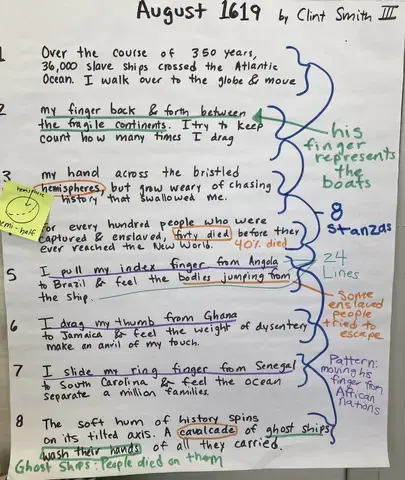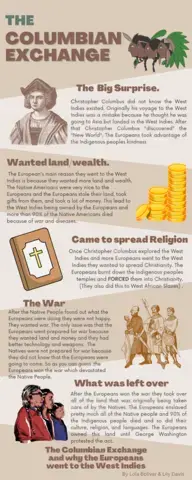This unit was created by the Audubon Gentilly team as part of the 2022 cohort of The 1619 Project Education Network. It is designed for facilitation across approximately 20 lessons.
Objectives:
Students will be able to...
- Understand how multiple perspectives on an event shed light on the truth.
- Understand and be able to articulate various ways in which the Columbian Exchange irreversibly changed people’s lives and civilizations.
- Use informational texts to compare and contrast individuals, events, ideas and concepts
- Explain the course and consequences of the Columbian Exchange, including its cultural, ecological, economic and political impact on Europe, the Americas, and West Africa.
- Compare and contrast the convergence of trade, cultural diffusion, and innovation in the Western Hemisphere after 1492.
- Describe the interactions between Native Americans (including Mesoamericas), Europeans, and Africans.
- Identify the major European powers that colonized North America and explain the economic motivations using concepts of scarcity and supply and demand, as well as the material outcomes of colonization
Unit Overview:
In this integrated unit, students will use nonfiction reading and writing skills to investigate the irreversible and profound impact of the Columbian Exchange, colonization, and the TransAtlantic slave trade on the world’s economy, agriculture and culture. Analysis of texts from The 1619 Project, as well as leveled nonfiction texts and several primary source documents, will help students compare and contrast the lives of communities in Europe, West Africa, and the Americas before and after these events.
Students will understand that these historical events profoundly impacted world history, that they continue to impact current events, and that different groups and stakeholders were impacted in different ways. Students will ultimately apply their analyses by writing three short essays documenting the impact of the Columbian Exchange and creating an infographic capturing key details explored in the unit.
Performance Task:
Mid-Unit Essays:
- Write an essay describing the impact of the Columbian Exchange on people around the world after 1492. Make sure to include at least three supporting reasons and evidence from the articles we’ve read to prove the reasons you’ve stated. [.pdf][.docx]
- Students compare and contrast the reaction of the Indigenous Americans to the European explorers with the way that the European explorers reacted to the Indigenous Americans. [.pdf][.docx]
Final Essay: Students write an informative essay exploring the prompt, “The exchange of people, goods, diseases, ideas, animals, and crops began after Christopher Columbus landed in what is now Haiti in 1492. This led to changes that impacted the world and its peoples, harming some and benefiting others through what is now called the Columbian Exchange. [.pdf][.docx]
Compare and contrast the impacts of the Columbian Exchange on European people, West African people and the Indigenous people of North and South America from 1492 through the 1700s. Be sure to include how some groups of people benefited while others were harmed.”
Essay Rubrics [.pdf][.docx]
Project: Students apply their knowledge of infographics to create one that illustrates the impacts of the Columbian Exchange on a specific population (ex- The Taino, the Mbundu people, the Aztec, Europeans, Colonial explorers, Monarchies)
Assessment/Evaluation:
- Daily formative assessment including text dependent questioning and discussion.
- Weekly summative assessment through expository writing to assess informational literacy skills and questioning to assess historical content knowledge.
- Mid-Unit Essays and final essays evaluated using the Essay Rubrics [.pdf][.docx]
- Performance tasks (see above) can be evaluated using a teacher-generated rubric in a similar style to this one.
- Standardized Unit assessment for historical content knowledge
20 lesson plans, including pacing, texts and multimedia resources, worksheets, and additional teaching materials. Download below, and scroll down to review key resources included in the unit plan.
Unit Resources
Common Core Standards:
CCSS.ELA-LITERACY.RI.5.3: Explain the relationships or interactions between two or more individuals, events, ideas, or concepts in a historical, scientific, or technical text based on specific information in the text.
CCSS.ELA-LITERACY.RI.5.5: Compare and contrast the overall structure (e.g., chronology, comparison, cause/effect, problem/solution) of events, ideas, concepts, or information in two or more texts.
CCSS.ELA-LITERACY.RI.5.6: Analyze multiple accounts of the same event or topic, noting important similarities and differences in the point of view they represent.
CCSS.ELA-LITERACY.RI.5.9: Integrate information from several texts on the same topic in order to write or speak about the subject knowledgeably.Louisiana 2022 5th grade Social Studies Standard 5.11: Analyze the motivations for the movement of people from Europe to the Americas and describe the effects of exploration by Europeans.
The following examples capture learning by fifth grade students in New Orleans, LA who engaged with this unit plan as part of the 2022-2023 school year.
- Students start the unit by evaluating how history can be better understood by exploring narratives from multiple perspectives. The following are examples of questions that students engage with while reading the poem "August 1619" by Clint Smith from The 1619 project:
* The narrator says: "I pull my index finger from Angola to Brazil & feel the bodies jumping from the ship.” Who was he referring to? Why do you think these people were jumping?
* What does the author mean when he says: "A cavalcade of ghost ships wash their hands of all they carried." What were the ghost ships? What does it mean if they 'wash their hands' of something?

2. After their first seven lessons, students apply details from the readings they explored to respond to the following prompt: Write an essay describing the impact of the Columbian Exchange on people around the world after 1492.
Are you ready to learn about the Columbian Exchange?... Well get comfy because this essay might be a little long but still very important. I have cool information for you to learn like… Some impacts of the Columbian Exchange on people around the world are access to new foods, exposure to disease, [and] you can’t forget the enslavement of certain groups of people.
fifth grade student from new orleans, la
3. The second mid-unit essay asks students to respond to the prompt: "Using these sources, compare and contrast the reactions of the Indigenous Americans to the European explorers with the way that the European explorers reacted to the Indigenous Americans."
Both groups were surprised to meet to each other because the things that seldom happen bring astonishment.
fifth grade student from new orleans, la
4.
In the final essay for the unit, students respond to the following prompt as part of an expository essay:
"The exchange of people, goods, diseases, ideas, animals, and crops began after Christopher Columbus landed in what is now called the Caribbean in 1492. This led to changes that impacted the world and its peoples, harming some and benefiting others through what is now called the Columbian Exchange. Compare and contrast the impacts of the Columbian Exchange on European people, West African people and the Indigenous people of North and South America from 1492 through the 1700s. Be sure to include how some groups of people benefited while others were harmed."
5. At the end of the unit, students applied their knowledge of infographics to create a graphic that illustrates the impacts of the Columbian Exchange on a specific population (ex- The Taino, the Mbundu people, the Aztec, Europeans, Colonial explorers, Monarchies)
- Student Example 1: Aztecs Infographic
- Student Example 2: Aztecs Infographic
- Student example 1: Infographics on The Columbian Exchange
- Student example 2: Infographic on The Columbian Exchange


